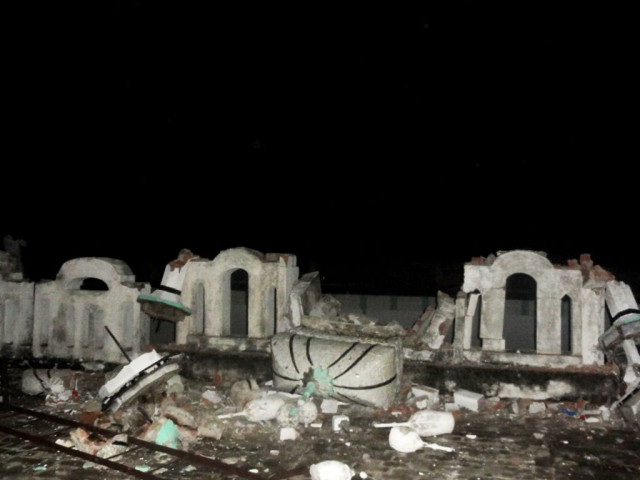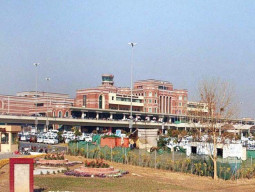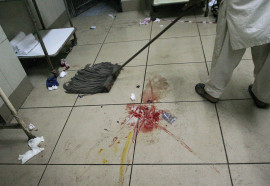
The demolition took place on the application of Saqib Shakeel Ghazi, Syed Iftikhar Kazmi and others from the Barelvi religious organisation called Tehreek-e-Tahaffuz-e-Islam. It had been filed to the Kharian police station.
The application asked the police to take action under the Section 298 B and C of the 1984 ordinance, which declares it illegal for Ahmadis to act or look like Muslims, to practice or propagate their faith and to call their worship place a “mosque”. There were no court orders for the demolition.
Police personnel, under the supervision of DSP Sultan Meeran, assisted by SHO Kharian Sadar Police Station Raja Zahid went to the worship place located near Kabari Bazar, Pul Nullah in Kharian.
Ahmadi community spokesperson in Kharian, Nasir Dar told The Express Tribune that six minarets had already been demolished whereas the police would demolish the two bigger ones later on as one was attached to the worship place’s electric supply and the other would fall on the building if not taken apart with the help of skilled labour.
The Kalma written on the front of the worship place’s entrance was also removed by the police as well, and the complimentary quotes about Prophet Muhammad (PBUH) were whitewashed.
SHO Raja Zahid said, “Everything was done amicably and peacefully and 80% of the work has been completed.”
Zahid further told The Express Tribune that after receiving the application from the afore-mentioned religious organizations, two meetings with the Ahmadi community and the applicants of the religious organization were held.
Afterwards a committee formed by DSP Sultan Meeran decided that it would be better to demolish the minarets. Zahid added that “noted and respected citizens were part of this committee also.”
SHO Raja Zahid said that the decision to demolish the minarets and other similar actions taken regarding Baitul Hamd were done “after a mutual consensus of the parties involved and the Qadiani community members who were very cooperative”.
“The reason for taking armed police personnel was for the protection of the Qadiyani community also,” said a police official.
Zahid added that, “We made sure that we were respectful, but the law of 298-B clearly states that Qadianis cannot call their worship place a ‘mosque’, so if it cannot be called that, then it cannot resemble the mosque either,” said Zahid.
However, Nasir Dar interprets the “mutual consensus” differently.
Dar said, “In our meeting with the police and the applicants, we told them that they can take off the Kalma and whitewash the quotes, if they think that displaying these texts was an illegal act by the community but told them that we would not do it with our own hands.”
Dar further said that when the minarets demolition came up, community thought that it was too much and told the police that “the minarets should only be demolished unless there is a court order to do so.”
“In fact we pleaded that the minarets should not be touched but nobody paid attention to our plight,” added Dar.
This is the first demolition of Ahmadi worship places’ minarets by Police after 1984. However there are a number of worship places which are sealed by the authorities, the community members say. There have been incidents where the Kalma has been removed or hidden from the worship places by the authorities, despite community protests.
He said that the community could not do anything except let the demolition happen because they do not disobey the law. Dar alleges that during the two combined meetings with the Tehreek-e-Tahaffuz-e-Islam members and the SHO, Saqib Shakeel Ghazi threatened that if the police did not demolish the minarets, they would do so themselves.
Baitul Hamd was built in 1980, four years before the 1984 Ordinance. The spokesperson for the Ahmadi community in Pakistan, Saleemuddin said, “Is there a patent for the design of a minaret that these people have?”
“All kinds of buildings have minarets and domes as part of their designs then why can’t the Ahmadis retain the ones which are on the pre-1984 worship places?”
Speaking to The Express Tribune, Hussain Naqi, a senior member of the Human Rights Commission of Pakistan said “The police and state are not timid in such incidents, they are not even appeasing to the extremist elements but conniving with them.”
Naqi added that the Chief Justice of Pakistan should take a suo motu. “Till the blasphemy laws are repealed such incidents will keep happening,” he said, adding that the police whitewashing the complimentary quotes for the Prophet and taking off the Kalma tiles was an act of blasphemy as well.
This is the third major incident this year which involves the status of an Ahmadi place of worship. In May 2012, a lower court in Lahore, ordered the police to act as per law on an application which asked for the demolition of Baitul Zikr in Lahore.
In March, couplets of the Holy Quran written on tiles at the Sultanpura place of worship in Lahore were desecrated when police got them removed via labourers.


















COMMENTS
Comments are moderated and generally will be posted if they are on-topic and not abusive.
For more information, please see our Comments FAQ